Earlier this century, when BMW Motorrad decided to shed its gray-haired, pipe-and-slippers image for good, rather than abandon the boxer engine that had been synonymous with the German company for more than 80 years, it completely revamped the flat opposed twin and its drivetrain. The 2004 R 1200 GS and RT that resulted were home runs, and the boxer has enjoyed consistent refinement and success since, right up to today’s new liquid-cooled model.
BMW’s next move was to fill the gap between the 650s and 1200s in its mid-2000’s motorcycle lineup to attract new customers. Rather than use a boxer engine, BMW partnered with Rotax in Austria to build a narrow, liquid-cooled 798cc parallel twin that feels and sounds like family but makes significantly more power per liter. Its initial deployment in the F 800 S sportbike and F 800 ST sport tourer for 2006 was just the beginning of a model-line expansion that has since brought us a full range of dynamic singles, twins, in-line fours and even sixes. The pipe and slippers are definitely gone, replaced with Red Bull and running shoes.
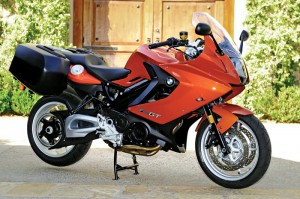
While the F 800 parallel twin went on to enjoy great success in the midsize GS adventure-touring models, the original F 800 S only lasted until 2010. And though we named the F 800 ST Best Sport-Touring Bike of 2007, it hasn’t exactly set the world on fire, either. Perhaps neither went quite far enough in the sport or sport-touring directions. That has changed with the new F 800 GT that replaces the ST for 2013. The GT offers more power, comfort and better wind protection atop a long list of improvements, yet the bike’s 497-pound wet weight is essentially unchanged from the ST.
The F 800 engine has the layout of a classic transverse parallel twin, with a DOHC, 4-valve-per-cylinder head, liquid cooling, EFI and 2-into-1 exhaust. Its wet clutch and 6-speed transmission are standard fare; the 12:1 compression, dry sump and belt final drive are not. Neither is the 360-degree firing order, with both pistons rising and falling together, giving the bike a somewhat boxerish exhaust note. The resulting primary and secondary imbalances are partially neutralized by a novel balancing system that moves a “dummy” connecting rod on a center crank journal in the opposite direction of the pistons. Maintenance is still straightforward, with valve inspections every 12,000 miles and belt replacement every 24,000.
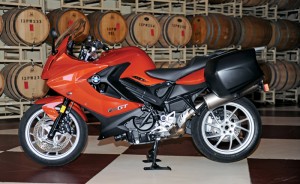
For 2013, revised fuel and ignition mapping give the F 800 engine a five-horsepower bump, from a claimed 85 at the crank to 90. On the Jett Tuning dyno, our test bike made a healthy 83.5 horsepower at 8,300 rpm at the rear wheel, and 58.4 lb-ft of torque at 6,100 rpm. Thumb the starter button and the GT barks to life with a livelier raspy growl courtesy of a shorter new silencer. Power delivery is brisk and linear, and the light bike is especially quick in the midrange, where there’s a noticeable bump in the torque curve. It shifts smoothly and easily and the clutch has a fairly light feel; the overall power impression is of an engine that is great for solo commuting and sport touring, but perhaps not quite strong enough without a lot of shifting and revving for two-up and fully loaded riding. That would also exacerbate its biggest weakness—buzzy vibration that is present in the grips, seat and footpegs at any engine speed above about 3,800 rpm. Despite the engine counterbalancing, the solid-mounted twin still passes along some vibration.
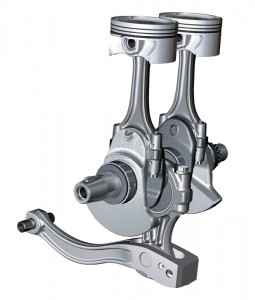
On the whole, the aluminum bridge-type perimeter frame and single-sided aluminum swingarm that pivots off the back of the engine are pretty cutting-edge stuff. Suspension is basic though, with a non-adjustable 43mm fork up front and unlinked single rear shock that is adjustable for rebound damping and spring preload with a remote knob. For more stability, the GT’s new swingarm is nearly two inches longer than the ST’s, and its suspension travel has been reduced 0.6-inch at each end. This also helps get the standard seat height down to 31.5 inches from 32.3 (with higher Comfort and lower seats available as options). The bike is well controlled in corners, with just a touch of fork dive under braking and good suspension compliance front and rear. Electronic Suspension Adjustment (ESA) is a welcome option on the new GT, and there’s a noticeable difference among its Comfort, Normal and Sport modes, though it only changes the rear rebound damping on this model.
Lighter restyled wheels contribute to sharper sportbike-like handling and bookend new bodywork that includes wider fairing upper and lowers and a larger fixed windscreen. The 0.8-inch higher handlebar is rubber mounted now to reduce felt vibration in the grips, and the footpegs are 0.4-inch lower and 0.4-inch farther forward for more legroom. Both the rider and passenger seats are a little wider and better padded, too, and the mirror stems are longer for better rearward visibility. This is a very comfortable bike even if it’s on the sporty side, with a slight forward lean to the bars and rearset pegs that are a bit high. The seat is just comfortable enough for long rides, and its shape helps us shorter-legged riders get our feet down at stops. Wind protection behind the taller, wider screen is very good now, though it can get noisy at times and can’t be adjusted.
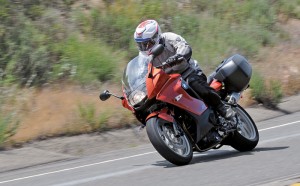
Triple disc brakes stop the F 800 GT right quick, with excellent feel at the front lever, though the rear pedal on our test bike felt somewhat spongy. ABS is standard, and rear wheel spin in low-traction conditions can be avoided with optional Automatic Stability Control (ASC), or traction control. In fact, you’ll probably be hard-pressed to find a base model at dealerships, which will most likely have bikes equipped with one or both of the Safety and Comfort packages that add ESA, ASC, a tire pressure monitor, heated grips, on-board computer and a centerstand. More options such as a top case, bag liners and LED turn signals are available, as well. Saddlebags are no longer standard, but the optional new hard-shell units are said to be larger than the ST’s and feature a unique lower shelf that eases loading. That shelf does seem to rob a lot of space from the bags, however, which are already compromised on the left by the muffler. A luggage rack is standard, and load capacity is up 24 pounds on the GT, to a promising 456 pounds before accessories.
A new instrument cluster, switches and controls include adjustable brake and clutch levers, and standard fuel level and engine temperature readouts. Despite the smallish 4.0-gallon tank under the seat, the bike’s good fuel economy gives it a range of nearly 200 miles, and the side-mounted filler means that luggage needn’t be removed to fill-up.
Overall, the F 800 GT has finally been brought up the same contemporary standard as the rest of BMW’s sport-touring lineup. Assuming the vibes aren’t an issue, it would make a great lightweight sport tourer for a long-distance rider, or a less-intimidating mount for a traveling companion who wants to ride his or her own.
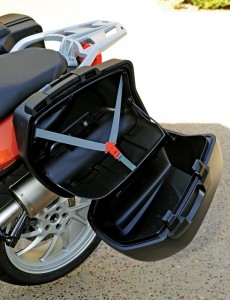
2013 BMW F 800 GT
Base Price: $11,890
Price as Tested: $14,257 (Safety Package, Comfort Package, side cases & mounts)
Warranty: 3 yrs., 36,000 miles
Website: bmwmotorcycles.com
Engine
Type: Liquid-cooled, transverse parallel twin
Displacement: 798cc
Bore x Stroke: 82.0 x 75.6mm
Compression Ratio: 12.0:1
Valve Train: DOHC, 4 valves per cyl.
Valve Insp. Interval: 12,000 miles
Fuel Delivery: EFI (Digital Engine Mgmt. BMS-K+), 46mm throttle bodies x 2
Lubrication System: Dry sump, 3.2-qt. cap.
Transmission: 6-speed, cable-actuated wet clutch
Final Drive: Belt
Electrical
Ignition: Digital BMS-K+
Charging Output: 400 watts max.
Battery: 12V 12AH
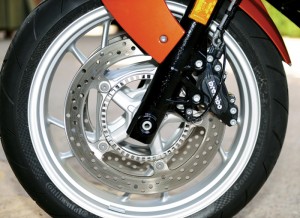
Chassis
Frame: Cast aluminum bridge-type w/ engine as stressed member & cast aluminum single-sided swingarm
Wheelbase: 59.6 in.
Rake/Trail: 25.8 degrees/3.7 in.
Seat Height: 31.5 in. (Comfort seat: 32.2 in., low seat: 30.1 in.)
Suspension, Front: 43mm stanchions, no adj., 4.9-in. travel
Rear: Single shock w/ 4.9-in. travel, remotely adj. for spring preload w/ electronically adj. rebound damping (ESA, as tested)
Brakes, Front: Dual 320mm floating discs w/ 4-piston opposed calipers & ABS
Rear: Single 265mm disc w/1-piston pin-slide caliper & ABS
Wheels, Front: Cast, 3.50 x 17 in.
Rear: Cast, 5.50 x 17 in.
Tires, Front: 120/70-ZR17
Rear: 180/55-ZR17
Wet Weight: 497 lbs. (as tested)
Load Capacity: 427 lbs. (as tested)
GVWR: 924 lbs.
Performance
Fuel Capacity: 4.0 gals., last 0.8 gal. warning light on
MPG: 89 PON min. (low/avg/high) 46.0/47.7/48.9
Estimated Range: 191 miles
Indicated RPM at 60 MPH: 3,450
(This article Long Distance Lightweight: 2013 BMW F 800 GT was published in the August 2013 issue of Rider magazine.)
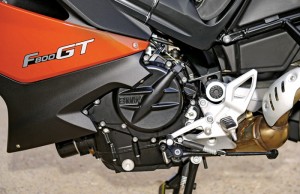 |
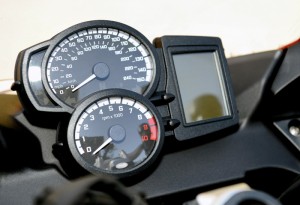 |

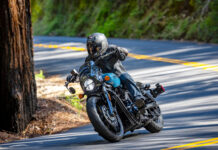






I haven’t ridden one myself, but I cannot recall reading a review of any F-powered Beemer that doesn’t reference the vibration. For that kind of dough you shouldn’t have to endure vibes. Maybe Triumph will give us a Trophy 800?
I have the 800ST, and I have actually, well, ridden the GT as well. I know the vibes they are referring to, but I think the issue is way overstated. I have owned 20 motorcycles, and I find this one as suitably smooth as the others. It’s a motorcycle, not a minivan, it lets you know that it is running, but I have never found vibration as objectionable on this model.
I have now done 1100 km on my new F 800 GT. My privies bike was a 2012 – F 650 GS. The balance in this engine is a big improvement to my previous experience. The gear box seems to be more precise also. The only thing I want to point out is the side cases that I find not to be up to what I expected. After having the GS side cases on my previous bike. This one seems smaller and I think you need to have the inner bag’s as well if you by them. The summary is a great bike that I can recommend!
I’ve just completed a 1900 km “test ride” on a F800GT. Of the bike options available to me for the ride, the F800GT was a great choice. The bike is light, close enough to the ground for me to get my feet down on stop, and responsive (take that with a grain of salt – I’m not an expert rider). And it was adequately comfortable for 9-hr riding days – with a bit of leg stretching.
However, I did object to some aspects. First, at about 5,000 RPM, it produces quite a prostate massage. That is highway cruising RPM (at least in some places) and makes the bike unsuitable for extensive highway riding. Additionally, the windscreen directs a lot of wind onto the shoulders and helmet at highway speed and riding in sleet resulted in an ice buildup on the upper-chest of my riding suit. I did not make peace with the back brake, consistently finding it weak. That resulted in some front-brake use in circumstances where the back would have been better. The frame rails alongside the engine heads get hot enough that I could not leave my un-gloved hand on them (guess: about 130F). That put a lot of heat into my legs on warm days. And the rear view mirrors mostly showed my own gloves and forearms.
But, as I said, it was the right bike for the ride.
The vibration solution for the parallel twin is the third cylinder as triumph found out years ago. Bmw had this down with the k75 but regressed when the pipe and slippers gave way to the red bull and running shoes, fads don’t usually wear well, even if they ever do happen to catch on at all.
A more detailed review than I could find anywhere else – very helpful. Could anyone please recommend a vibe-free alternative to the F800GT? The F800GT sounds perfect in all other respects, but I’m very averse to vibrations – they really tire me out quickly on long rides.
I’m planning to upgrade from my current Suzuki GW250 – though almost entirely vibe-free, it’s far too low on power to handle long trips. My height is 5-feet-7-inches, so saddle height is a big issue – thus the need for a lightweight tourer with saddle height less than 31 inches. Belt or shaft drive is also important, because of the high dirt, mud and grit conditions present where I live, tend to demand very high maintenance with chain drives.
Any suggestions would be greatly appreciated.
The Honda VFR800 is an awesome bike, that has virtually no vibration. Interestingly, I had my Honda VFR800 written off recently and purchased a BMW F800 st as a replacement. I appreciate that there will be some increased vibration and a reduction in acceleration, but in reality, this is pretty much a moot point for me. A better riding posture, better windscreen and the fact that the BMW is 70 pounds lighter, even with the 20 plus horsepower deficit, only means a 0 to 60 time differential of .4 seconds, and the top end is only an 8 mph difference. The inclusion of all of the enhancements, belt drive, top box, hard panniers, trip computer, tire pressure monitor, ABS, gear indicator etc., more than make up for any deficit in relation to straight-line speed. I haven’t found that I need to do in excess of 125 mph to date, for any rational reason, hence the BMW.
I currently have about 22,000 miles on my GT. I haven’t had any problems with vibrations and I have done long rides. I did a 3000 mile trip from Fort Worth through eastern Wi. and up to Duluth, Mn. before riding back to Texas. The first day was a little long, 750 miles and I didn’t do any prep rides. After that I limited it to 500 miles a day. Mine has the comfort seat and I am 5’5″, I have to stretch a little, but I have learned to compensate. This my 10th bike and with the last 2 included I have logged over 100,000 miles. This is my only bike and I have the top box which is one of the best accessories to add. I also have to side panniers, but only use those for longer rides or where I need extra storage.
This is an excellent all round motorcycle. I covered 2200 miles in 5 days (600 on one day) so touring is not an issue. My bike came with the “Comfort Seat” option which has extra padding. I have never felt vibration in the seat. There is a bit of vibration in the handlebars but much less than other bikes I have owned. The solution is a $18 throttle lock from Aerostich so you can take your hand off the throttle occasionally. The left hand is not a problem probably because it is not gripped as tightly.
The belt drive is great (no chain lubing and no oil on the swing arm etc.). There is plenty of power for two up riding and the passenger seat is very good. Rear shock preload is easily adjusted. Handling is rock steady. I rode 6 hours through the desert in temps up to 109F at 85 mph and the water temp gauge never went above normal operating. All around it is a well designed bike, great for commuting and solo touring.
I bought an F800GT last year and like the bike a lot. However, the vibration is a real problem. I end many longer journeys with white fingers and it is not the cold as the heated grips work fine. BMW should really sort this as the bike is in other ways excellent.
I’ve had my f800gt since August 2013. This was and still is my first bike. And I totally agree that it is a good bike. It a good bike that could be a lot better. The vibration on the bike comes from the motor having to work extra hard at higher rpms, it doesn’t take a brain surgeon to figure that one out. Which can only mean the bike is under powered. Which is why the dealership here can’t sell them, and now that I want to get another bike the dealership where I bought mine doesn’t want to take it back on a trade because they already have 3 they can’t sell. I don’t understand the concept of redesigning a motorcycle and not making it more appealing to a wider market. With nothing else in their sport touring line Between the f800gt and the k1300s why would BMW not give the f800gt at least 100 hp. Last year the dealership here got in 3 used vrf800’s . All 3 sold within 2 weeks of being on the sales floor. I rode one and the f800gt although not by much was more comfortable the vfr was a little more fun to ride. If I’m not mistaken the f800gt actually has a bigger motor then the vfr. Looks, ride and comfort the f800gt has all 3 but the lack of power keeps it from being anymore popular at least in the states. With in a couple years if the motor isn’t upgraded I don’t see it being sold here in the states anymore.
If you find 90 hp underpowered, leading to more vibration than you want, BMW offers several different boxer-twin 1150-to-1200 cc RT models, as of your comment in 2015. As someone who’s had a couple dozen motorcycles over 40 years, from 185cc to 1800cc, mostly standards and sport tourers, I find the F800GT a great middleweight sport tourer, good for long days including some tight mountain roads, with vibration that’s certainly within acceptable limits.
I have 324000 miles on my rt1100 and can no longer afford the constant repair bills. So, am looking at the f800gt to replace it. However, the vibration issue keeps coming up in road test reviews, along with the low power. I only ride solo but would miss the radio, the ohlins, and staintune muffler.
The price is not all that much lower than the cost of a 1200 rt, especially if all available options ar added.
What really attracts me is the more manageable lighter weight over the RT’s.
Did you end up with the F800 GT? I have a similar situation as you have. I have a 2004 are 1150rt. And I have 120,000 miles on mine. But I am 60 years old now and the weight of the RT is beginning to be a problem. So I am thinking about something lighter but would still like some wind protection and the saddlebags.
Agreed. It’s what led me to buy the F800 st.
As of now I have 15,400 on my f800gt. Its hard to believe in just over a year I can tell the difference in how I ride. And can actually see what the limits of the f800gt are. I’ve had the bike to 135mph (at least that’s what I was told I was clocked at). The bike did not apreciaite it either. What I will say is that the GT is a better then good bike, but for its size it’s underpowered, especially with the other bike manufacturers getting into the sport touring market, Ducati has two bikes that ar
e less expensive aND have more power and torque. For 2016 the GT is over priced. 13,990 before taxes, tags, and whatever else can be added on. Either way it’s will wind up costing close to or over 15g. If you want to pay out that kind of money for a 2 cylinder bike with less than 100hp be my guest.
I have owned my f800 GT for about 6 weeks and I put over 2,000 mi on it. It’s a great bike and I don’t have any issues with vibration. the design is pretty impressive as it’s very flickable in corners and also a great touring bike even with two up. The 90 horsepower and 63 lb of torque seem adequate for two up riding even in the mountains. It is a very usable gearbox with six gear being quite amazing It’s the usable torque extends from about 40 mph well up passing speeds. I never have to worry about downshifting even with a lot of weight on the bike. It gets great gas mileage especially if you go pretty slow on back roads. On a recent 1200 mile trip that was two up the whole time plus full of gear I average 55 miles per gallon. Now for the negatives: I also feel the back brake is underpowered and it sometimes makes stopping awkward. The other issue I see is that the side cases are too small and difficult to use. I’d much rather prefer an old adventure style side case but I guess That’s because I prefer motorcycle camping and could use the extra storage and I’ve never been real interested in how sexy my bike looks :-). Overall, it’s a great adventure / touring bike for me and my girlfriend and I love taking this bike on long journeys and seeing where the road leads us. One final note, I did take this bike on many gravel roads and up a sketchy logging road that I didn’t really intend to but it handled it well. I have a set of Michelin tires on the thing and traction on all surfaces has been pretty tremendous.
I have F800GT with over 42000 miles on the clock. Rides like new. No vibrations like people are mentioning here. It’s smooth, fast, economic, fun.
These bikes are totally underrated and well worth a look at for anyone who wants a bike that can go quick, go long distances, be reliable.
Lot of reviews say this bike tops out at 120mph. My bike has a calibrated speedo (police bike) and tops out 20mph over this.